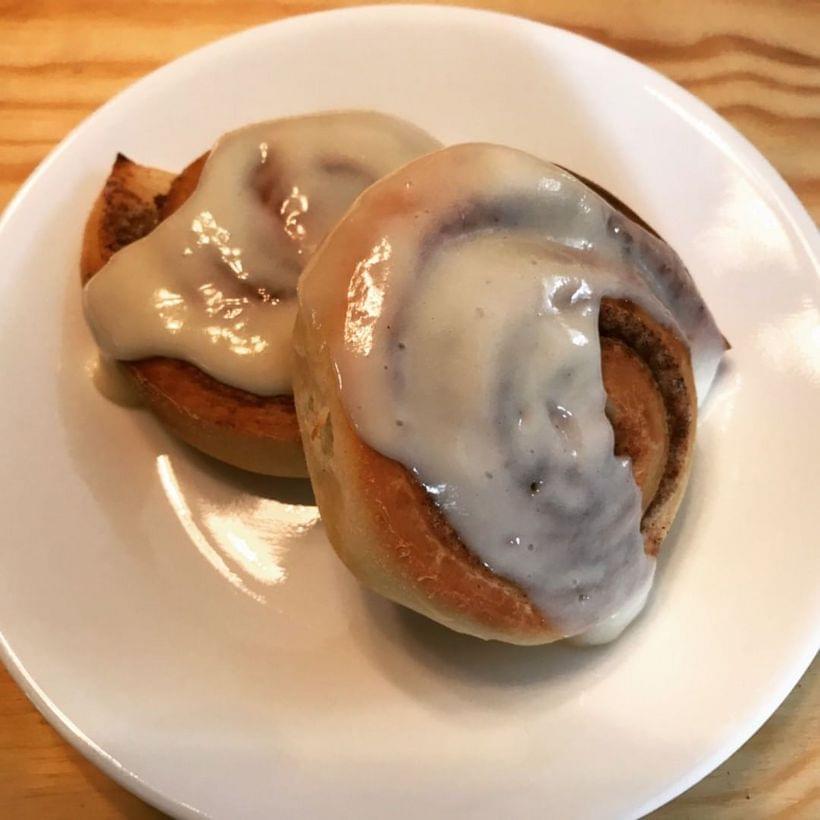Sourdough Cinnamon Rolls
Skip to the recipe
Listen, I think that you should make yourself something nice.
Look, I am not up for a 13-step recipe.
Hard same. I’m one (1) more stressful event away from posting recipes to the tune of “dunk a Double Stuf Oreo in Lao Gan Ma. That’s dinner now. It’s the end of the world; who gives a shit.”
You got this one, though. It reads as steppy, but there are a bunch of breakpoints built into this thing.
You’ll be able to mix up the levain in ten minutes, tops. The filling and icing you can whip up quick and chuck in the fridge for whenever you’re done making the rest. The final dough comes together in fairly short order; it’s an easy dough to work with, and you can leave it in the fridge for a couple days before the final shaping. Fifteen minutes here, half an hour there. Make yourself some cinnamon rolls. They’re good.
Natural Leavening vs. Instant Yeast
These are sourdough, on account of how it’s the kind of yeast that keeps on making more of itself, so I always have some. If you’re doing this with instant yeast, I’ll wager 2 tsp. of it will get you there—just disregard any of the timings in the recipe and keep a close eye out for those “roughly doubled in size” markers.
Recipe: Sourdough Cinnamon Rolls
Hang in there.
Ingredients
Instructions Levain
-
50 G. Starter
-
100 G. Water, between 90°f and 110°f
-
100 G. All-purpose flour
Instructions Filling
-
1/4 C. Granulated Sugar
-
1/8 C. Light Brown Sugar
-
1/2 Tbsp. Ground Cinnamon
-
1 tsp. Kosher Salt
-
2 Tbsp. All-purpose flour
-
3 Tbsp. Unsalted Butter, melted
Instructions Icing
-
115 G. Cream Cheese, at room temperature (about half of an eight-ounce package)
-
1 C. Confectioners Sugar
-
2 Tbsp. Unsalted Butter, melted
Instructions Final Dough
-
400 G. AP Flour, plus a few tablespoons, reserved
-
1 tsp. Kosher Salt
-
1/4 C. Granulated Sugar
-
1/4 C. Whole Milk, between 90°f and 110°f
-
2 Large Eggs
-
1/4 C. Greek Yogurt
-
4 Tbsp. Unsalted Butter, melted
-
The entire levain
Instructions
Instructions For the Levain
Add fed starter and lukewarm water to a mixing bowl; swirl until water is cloudy and starter is mostly dispersed. Mix in flour until fully incorporated.
Let rest at room temperature, loosely covered, overnight.
Instructions For the Filling
Whisk together dry ingredients and reserve.
Instructions For the Icing
Thoroughly beat together together all ingredients until smooth.
Instructions For the Final Dough
Lightly whisk together milk, eggs, yogurt, and melted butter in a large mixing bowl or the bowl of a stand mixer.
Check that the temperature of the wet ingredients is no higher than 110°f before adding the levain to the wet ingredients, stirring until it is mostly dispersed.
Add remaining dough ingredients and mix, adding additional flour a tablespoon at a time until the dough just comes together in a loose ball.
Add salt, and machine knead on low speed using a dough hook or spiral for four minutes, or hand knead for five minutes.
Hand knead for a minute or two on a lightly floured surface, then form into a ball.
Remove dough to a lightly oiled bowl or proofing bucket and either mist the dough lightly with spray oil or roll it around the container to prevent drying. Seal the bowl/container with plastic wrap and let rest at room temperature for two hours. Move container to refrigerator and allow to ferment overnight.
On baking day, punch dough down and turn out onto floured surface. Knead lightly to deflate.
Roll dough out into a large rectangle and brush with melted butter. Dust generously with filling, then roll dough into a tight cylinder, starting from one of the wide ends.
Cut filled dough into one inch thick rounds using a sharp bread knife, thin thread, or please-not-mint-flavored dental floss.
Arrange rounds at the bottom of a parchment-lined and spray-oiled baking tin or cake pan, with a little space between them for oven spring.
Cover loosely and let rise in warm place until almost double in size, about 1 1/2–2 hours. Preheat your oven to 350°f during this time.
Bake, uncovered, for about 20–25 minutes (or until very lightly browned at the tops and edges).
Spoon icing over buns while still warm.